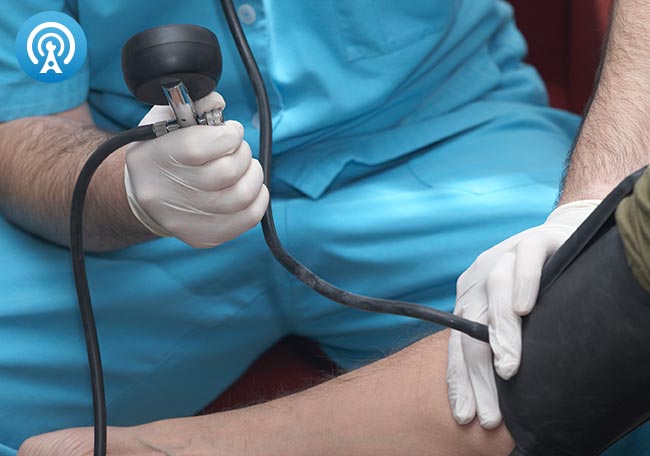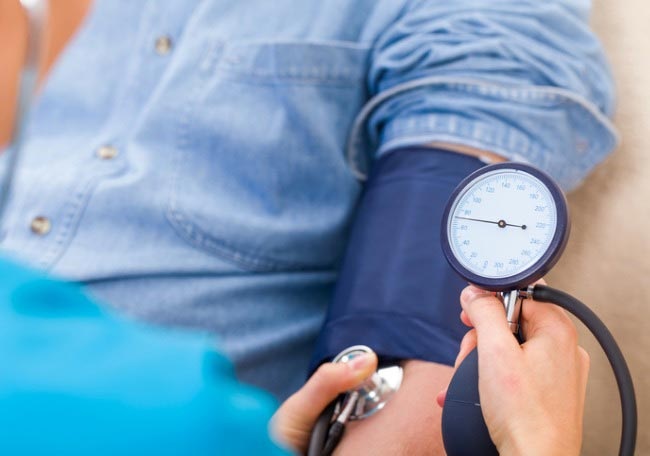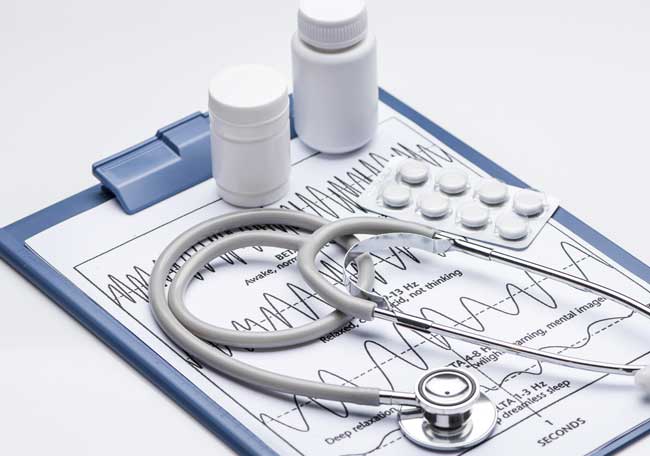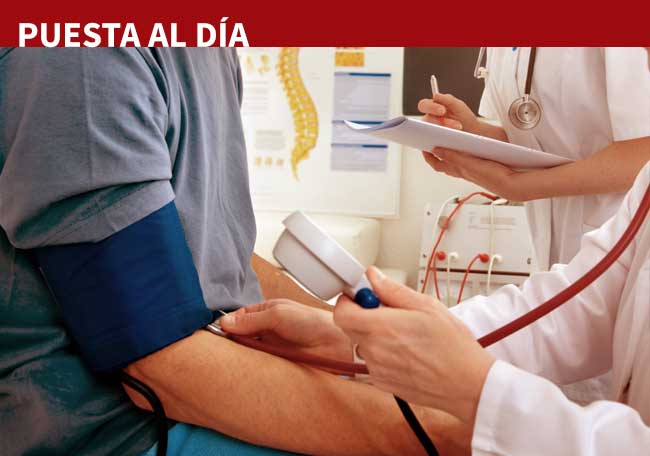Hipertensión Arterial: una puesta al día imprescindible

1. Luft, F. C. Twins in cardiovascular genetic research. Hypertension 37, 350–356 (2001).
2. Fagard, R. et al. Heritability of conventional and ambulatory blood pressures: a study in twins. Hypertension 26, 919–924 (1995).
3. Surendran, P. et al. Trans-ancestry meta-analyses identify rare and common variants associated with blood pressure and hypertension. Nat. Genet. 48, 1151–1161 (2016).
4. Ehret, G. B. et al. The genetics of blood pressure regulation and its target organs from association studies in 342,415 individuals. Nat. Genet. 48, 1171–1184 (2016).
5. Liu, C. et al. Meta-analysis identifies common and rare variants influencing blood pressure and overlapping with metabolic trait loci. Nat. Genet. 48, 1162–1170 (2016).
6. Dominiczak, A., Delles, C. & Padmanabhan, S. Genomics and precision medicine for clinicians and scientists in hypertension. Hypertension 69, e10–e13 (2017).
7. Lifton, R. P., Gharavi, A. G. & Geller, D. S. Molecular mechanisms of human hypertension. Cell 104, 545–556 (2001).
8. Ehret, G. B. & Caulfield, M. J. Genes for blood pressure: an opportunity to understand hypertension. Eur. Heart J. 34, 951–961 (2013).
9. Maass, P. G. et al. PDE3A mutations cause autosomal dominant hypertension with brachydactyly. Nat. Genet. 47, 647–653 (2015).
10. Forouzanfar, M. H. et al. Global, regional, and national comparative risk assessment of 79 behavioural, environmental and occupational, and metabolic risks or clusters of risks, 1990–2015: a systematic analysis for the Global Burden of Disease Study 2015. Lancet 388, 1659–1724 (2016).
11. Blood Pressure Lowering Treatment Trialists’ Collaboration. Blood pressure-lowering treatment based on cardiovascular risk: a meta-analysis of individual patient data. Lancet 384, 591–598 (2014).
12. Page, L. B., Damon, A. & Moellering, R. C. Antecedents of cardiovascular disease in six Solomon Islands societies. Circulation 49, 1132–1146 (1974).
13. Poulter, N. R., Prabhakaran, D. & Caulfield, M. Hypertension. Lancet 386, 801–812 (2015).
14. Rose, G. & Day, S. The population mean predicts the number of deviant individuals. BMJ 301, 1031–1034 (1990).
15. Mills, K. T. et al. Global Disparities of hypertension prevalence and control: a systematic analysis of population-based studies from 90 countries. Circulation 134, 441–450 (2016).
16. Forouzanfar, M. H. et al. Global burden of hypertension and systolic blood pressure of at least 110 to 115 mmHg, 1990–2015. JAMA 317, 165 (2017).
17. Lewington, S. et al. Age-specific relevance of usual blood pressure to vascular mortality: a meta-analysis of individual data for one million adults in 61 prospective studies. Lancet 360, 1903–1913 (2002).
18. Rapsomaniki, E. et al. Blood pressure and incidence of twelve cardiovascular diseases: lifetime risks, healthy life-years lost, and age-specific associations in 1.25 million people. Lancet 383, 1899–1911 (2014).
19. Stamler, J., Stamler, R. & Neaton, J. D. Blood pressure, systolic and diastolic, and cardiovascular risks. US population data. Arch. Intern. Med. 153, 598–615 (1993).
20. Klag, M. J. et al. Blood pressure and end-stage renal disease in men. N. Engl. J. Med. 334, 13–18 (1996).
21. Goff, D. C. et al. 2013 ACC/AHA Guideline on the Assessment of Cardiovascular Risk. J. Am. Coll. Cardiol. 63, 2935–2959 (2014).
22. Hall, M. E. & Hall, J. E. in Hypertension: A Companion to Braunwald’s Heart Disease 3rd edn (eds Bakris, G. L. & Sorrentino, M.) 33–51 (Elsevier, 2018).
23. Gangwisch, J. E. A review of evidence for the link between sleep duration and hypertension. Am. J. Hypertens. 27, 1235–1242 (2014).
24. Palagini, L. et al. Sleep loss and hypertension: a systematic review. Curr. Pharm. Des. 19, 2409–2419 (2013).
25. Mikael, L. de R. et al. Vascular aging and arterial stiffness. Arq. Bras. Cardiol. 109, 253–258 (2017).
26. Sindler, A. L. et al. Nitrite supplementation reverses vascular endothelial dysfunction and large elastic artery stiffness with aging. Aging Cell 10, 429–437 (2011).
27. Steppan, J., Barodka, V., Berkowitz, D. E. & Nyhan, D. Vascular stiffness and increased pulse pressure in the aging cardiovascular system. Cardiol. Res. Pract. 2011, 263585 (2011).
28. Page, I. H. Pathogenesis of arterial hypertension. JAMA 140, 451–458 (1949).
29. Harrison, D. G. The Mosaic Theory revisited: common molecular mechanisms coordinating diverse organ and cellular events in hypertension. J. Am. Soc. Hypertens. 7, 68–74 (2013).
30. Feng, W., Dell’Italia, L. J. & Sanders, P. W. Novel paradigms of salt and hypertension. J. Am. Soc. Nephrol. 28, 1362–1369 (2017).
31. Wilck, N. et al. Salt-responsive gut commensal modulates TH17 axis and disease. Nature 551, 585 (2017).
32. Singh, A. & Williams, G. H. Textbook of Nephro- Endocrinology 2nd edn (Academic Press, 2017).
33. Varagic, J., Ahmad, S., Nagata, S. & Ferrario, C. M. ACE2: angiotensin II/angiotensin-(1–7) balance in cardiac and renal injury. Curr. Hypertens. Rep. 16, 420 (2014).
34. Ferrario, C. M. ACE2: more of Ang-(1–7) or less Ang II? Curr. Opin. Nephrol. Hypertens. 20, 1–6 (2011).
35. Zimmerman, D. & Burns, K. D. Angiotensin-(1–7) in kidney disease: a review of the controversies. Clin. Sci. 123, 333–346 (2012).
36. Zhou, Z. H. & Bubien, J. K. Nongenomic regulation of EnaC by aldosterone. Am. J. Physiol. Cell Physiol. 281, C1118–C1130 (2001).
37. McCurley, A. & Jaffe, I. Z. Mineralocorticoid receptors in vascular function and disease. Mol. Cell. Endocrinol. 350, 256–265 (2012).
38. Kerkelä, R., Ulvila, J. & Magga, J. Natriuretic peptides in the regulation of cardiovascular physiology and metabolic events. J. Am. Heart Assoc. 4, e002423 (2015).
39. Woodard, G. E. & Rosado, J. A. Chapter 3 Natriuretic peptides in vascular physiology and pathology. Int. Rev. Cell. Mol. Biol. 268, 59–93 (2008).
40. Curry, F.-R. E. Atrial natriuretic peptide: an essential physiological regulator of transvascular fluid, protein transport, and plasma volume. J. Clin. Invest. 115, 1458–1461 (2005).
41. Armaly, Z., Assady, S. & Abassi, Z. Corin: a new player in the regulation of salt-water balance and blood pressure. Curr. Opin. Nephrol. Hypertens. 22, 713–722 (2013).
42. Schlueter, N. et al. Metabolic actions of natriuretic peptides and therapeutic potential in the metabolic syndrome. Pharmacol. Ther. 144, 12–27 (2014).
43. Khaddaj Mallat, R., Mathew John, C., Kendrick, D. J. & Braun, A. P. The vascular endothelium: a regulator of arterial tone and interface for the immune system. Crit. Rev. Clin. Lab. Sci. 54, 458–470 (2017).
44. Sandoo, A., van Zanten, J. J. C. S. V., Metsios, G. S., Carroll, D. & Kitas, G. D. The endothelium and its role in regulating vascular tone. Open Cardiovasc. Med. J. 4, 302–312 (2010).
45. Spieker, L. E., Flammer, A. J. & Lüscher, T. F. in The Vascular Endothelium II (Moncada, S. & Higgs, A.) 249–283 (Springer, Berlin, Heidelberg, 2006).
46. Ayub, T., Khan, S. N., Ayub, S. G., Dar, R. & Andrabi, K. I. Reduced nitrate level in individuals with hypertension and diabetes. J. Cardiovasc. Dis. Res. 2, 172–176 (2011).
47. Panza, J. A., Casino, P. R., Badar, D. M. & Quyyumi, A. A. Effect of increased availability of endothelium-derived nitric oxide precursor on endothelium-dependent vascular relaxation in normal subjects and in patients with essential hypertension. Circulation 87, 1475–1481 (1993).
48. Kohan, D. E. & Barton, M. Endothelin and endothelin antagonists in chronic kidney disease. Kidney Int. 86, 896–904 (2014).
49. Serrano-Ponz, M. et al. Temporal profiles of blood pressure, circulating nitric oxide, and adrenomedullin as predictors of clinical outcome in acute ischemic stroke patients. Mol. Med. Rep. 13, 3724–3734 (2016).
50. Vendégh, Z. et al. Calcitonin gene-related peptide, substance P, nitric oxide and epinephrine modulate bone marrow micro circulation of the rabbit tibia and femur. Clin. Hemorheol. Microcirc. 45, 9–17 (2010).
51. Yu, M. et al. Antihypertensive effect of glucagon-like peptide 1 in Dahl salt-sensitive rats. J. Hypertens. 21, 1125–1135 (2003).
52. Popolo, A., Autore, G., Pinto, A. & Marzocco, S. Oxidative stress in patients with cardiovascular disease and chronic renal failure. Free Radic. Res. 47, 346–356 (2013).
53. Lazich, I. & Bakris, G. L. Endothelin antagonism in patients with resistant hypertension and hypertension nephropathy. Contrib. Nephrol. 172, 223–234 (2011).
54. Dharmashankar, K. & Widlansky, M. E. Vascular endothelial function and hypertension: insights and directions. Curr. Hypertens. Rep. 12, 448–455 (2010).
55. Heymans, C. & Delaunois, A. L. Fundamental role of the tone and resistance to stretch of the carotid sinus arteries in the reflex regulation of blood pressure. Science 114, 546–547 (1951).
56. Pijacka, W. et al. Carotid sinus denervation ameliorates renovascular hypertension in adult Wistar rats. J. Physiol. 594, 6255–6266 (2016).
57. de Leeuw, P. W. et al. Sustained reduction of blood pressure with baroreceptor activation therapy. Results of the 6-year open follow-up. Hypertension 69, 836–843 (2017).
58. Grassi, G. et al. Excessive sympathetic activation in heart failure with obesity and metabolic syndrome: characteristics and mechanisms. Hypertension 49, 535–541 (2007).
59. Mancia, G. & Grassi, G. The autonomic nervous system and hypertension. Circ. Res. 114, 1804–1814 (2014).
60. Augustyniak, R. A. et al. Sympathetic nerves and the progression of chronic kidney disease during 5/6 nephrectomy: studies in sympathectomized rats. Clin. Exp. Pharmacol. Physiol. 37, 12–18 (2010).
61. Augustyniak, R. A., Tuncel, M., Zhang, W., Toto, R. D. & Victor, R. G. Sympathetic overactivity as a cause of hypertension in chronic renal failure. J. Hypertens. 20, 3–9 (2002).
62. DiBona, G. F. Sympathetic nervous system and hypertension. Hypertension 61, 556–560 (2013).
63. Grassi, G., Mark, A. & Esler, M. The sympathetic nervous system alterations in human hypertension. Circ. Res. 116, 976–990 (2015).
64. Grassi, G., Cattaneo, B. M., Seravalle, G., Lanfranchi, A. & Mancia, G. Baroreflex control of sympathetic nerve activity in essential and secondary hypertension. Hypertension 31, 68–72 (1998).
65. Smith, P. A., Graham, L. N., Mackintosh, A. F., Stoker, J. B. & Mary, D. Relationship between central sympathetic activity and stages of human hypertension. Am. J. Hypertens. 17, 217–222 (2004).
66. Fujita, T. Mechanism of salt-sensitive hypertension: focus on adrenal and sympathetic nervous systems. J. Am. Soc. Nephrol. 25, 1148–1155 (2014).
67. Mu, S. et al. Epigenetic modulation of the renal β-adrenergic–WNK4 pathway in salt-sensitive hypertension. Nat. Med. 17, 573–580 (2011).
68. Harrison, D. G. & Bernstein, K. E. in in Hypertension: A Companion to Braunwald’s Heart Disease 3rd edn (eds Bakris, G. L. & Sorrentino, M.) 60–69 (Elsevier, 2018).
69. Devallière, J. & Charreau, B. The adaptor Lnk (SH2B3): an emerging regulator in vascular cells and a link between immune and inflammatory signaling. Biochem. Pharmacol. 82, 1391–1402 (2011).
70. Rodriguez-Iturbe, B. Autoimmunity in the pathogenesis of hypertension. Hypertension 67, 477–483 (2016).
71. Mattson, D. L. et al. Genetic mutation of recombination activating gene 1 in Dahl salt-sensitive rats attenuates hypertension and renal damage. AJP Regul. Integr. Comp. Physiol. 304, R407–R414 (2013).
72. Roush, G. C. et al. Prognostic impact from clinic, daytime, and night-time systolic blood pressure in nine cohorts of 13 844 patients with hypertension. J. Hypertens. 32, 2332–2340 (2014).
73. Stergiou, G. S. et al. Methodology and technology for peripheral and central blood pressure and blood pressure variability measurement. J. Hypertens. 34, 1665–1677 (2016).
74. Parati, G. et al. European Society of Hypertension Practice Guidelines for home blood pressure monitoring. J. Hum. Hypertens. 24, 779–785 (2010).
75. O’Brien, E. et al. European Society of Hypertension Position Paper on ambulatory blood pressure monitoring. J. Hypertens. 31, 1731–1768 (2013).
76. Muntner, P. & Whelton, P. K. Using predicted cardiovascular disease risk in conjunction with blood pressure to guide antihypertensive medication treatment. J. Am. Coll. Cardiol. 69, 2446–2456 (2017).
77. Mancia, G. et al. 2013 ESH/ESC Guidelines for the management of arterial hypertension. J. Hypertens. 31, 1281–1357 (2013).
78. Pickering, T. G. Recommendations for blood pressure measurement in humans and experimental animals. Part 1: Blood pressure measurement in humans: a statement for professionals from the Subcommittee of Professional and Public Education of the American Heart Association Council on High Blood Pressure Research. Circulation 111, 697–716 (2005).
79. Whelton, P. K. The elusiveness of population-wide high blood pressure control. Annu. Rev. Publ. Health 36, 109–130 (2015).
80. Primatesta, P. & Poulter, N. R. Improvement in hypertension management in England: results from the Health Survey for England 2003. J. Hypertens. 24, 1187–1192 (2006).
81. Ashworth, M., Medina, J. & Morgan, M. Effect of social deprivation on blood pressure monitoring and control in England: a survey of data from the quality and outcomes framework. BMJ 337, a2030 (2008).
82. Serumaga, B. et al. Effect of pay for performance on the management and outcomes of hypertension in the United Kingdom: interrupted time series study. BMJ 342, d108 (2011).
83. Poulter, N. R. & Lackland, D. T. May Measurement Month: a global blood pressure screening campaign. Lancet 389, 1678–1680 (2017).
84. He, J. et al. Migration, blood pressure pattern, and hypertension: the Yi Migrant Study. Am. J. Epidemiol. 134, 1085–1101 (1991).
85. Poulter, N. R. et al. The Kenyan Luo migration study: observations on the initiation of a rise in blood pressure. BMJ 300, 967–972 (1990).
86. Rosenthal, T. The effect of migration on hypertension and other cardiovascular risk factors: a review. J. Am. Soc. Hypertens. 8, 171–191 (2014).
87. Klag, M. J. et al. The contribution of urinary cations to the blood pressure differences associated with migration. Am. J. Epidemiol. 142, 295–303 (1995).
88. Whelton, P. K. et al. The effects of nonpharmacologic interventions on blood pressure of persons with high normal levels. Results of the Trials of Hypertension Prevention, Phase I. JAMA 267, 1213–1220 (1992).
Comentarios
Para ver los comentarios de sus colegas o para expresar su opinión debe ingresar con su cuenta de IntraMed.










